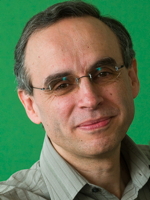
Nikolaus Pfanner(*1956 Simmerberg im Allgäu) received the State Research Prize for his work in the area of Molecular Cell Biology.
Professor Pfanner is the first scientist ever to decipher the composition of the power plants of the cell (mitochondria). In addition, he and his team gathered insights on how proteins, which are active in the power plants, find their way to their place of work.
When biologists want to explain the structure of a cell, they often fall back on the analogy of a city. The nucleus is a kind of city hall, around which numerous institutions and services are gathered. The power plants, the so-called mitochondria, have special significance, because they deliver the cell’s energy. The cellular city is inhabited primarily by proteins. They fulfill numerous tasks as the “workers of the cell,” a fact that has been known for around 50 years.
But how do the almost 1,000 proteins that work at the power plants get to their place of work, and what exactly do they do when they arrive? Professor Pfanner, whose scientific career took him from the one-room school in his native Allgäu to Munich, Princeton (USA), and finally Freiburg, set out to answer precisely these questions in his research. With success: He and his team have now discovered what more than 25 research groups around the world have been looking for: The composition of the cellular power plants and the transport machines the proteins use to get to the right workplace. Disruptions in the process of protein transport can lead to diseases, particularly in the central nervous system and the muscles. The research on mitochondria lays the foundations for explaining the causes of genetic diseases and thus, in the long run, for developing therapies.
Mitochondria and the transport of proteins into the mitochondria is the main focus of Nikolaus Pfanner’s research. “We are – at least in part – already capable of determining the function individual proteins serve when they arrive,” says Pfanner. For the first comprehensive analysis of all proteins in the mitochondria, he and his colleagues identified and differentiated roughly 1,000 different proteins, over 200 of them for the first time ever.
Simple Baker’s Yeast Yields Far-Reaching Results
Pfanner succeeded in explaining important principles of protein transport and the dynamic structure of mitochondria with experiments on cells of baker’s yeast. His results are also valid for fungi as well as for plants, animals, and humans. This research concentrates particularly on how the proteins get to the right place, the right place of work. “We were able to confirm that no proteins at all can make it to the mitochondria if just a single particular protein is missing. Even the tiniest changes in structure and composition have direct consequences for the entire cell,” explains Pfanner. One wrong transport, one protein in the wrong place, one wrong form – such tiny defects in the mitochondria often lead to diseases of the central nervous system. “We are beginning to develop a molecular understanding of diseases. We have reached the point where we can start conducting worthwhile applied research on the basis of previous fundamental research.”
Further research awards:
- Hector Research Prize (2011)
- Gottfried Wilhelm Leibniz Prize (2004)
- Max Planck Research Prize (2002)







